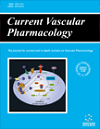- Home
- A-Z Publications
- Current Vascular Pharmacology
- Previous Issues
- Volume 3, Issue 2, 2005
Current Vascular Pharmacology - Volume 3, Issue 2, 2005
Volume 3, Issue 2, 2005
-
-
Cardiovascular Toxicity from the Perspective of Oxidative Stress, Electron Transfer, and Prevention by Antioxidants
More LessAuthors: Peter Kovacic and Lisa A. ThurnThis review demonstrates that oxidative stress, reactive oxygen species, and electron transfer can serve as unifying mechanistic themes for large numbers of cardiovascular toxins, both endogenous and exogenous. Lipid peroxidation is a prevalent insult. Common among the various conditions are atherosclerosis and arrhythmia. The preventive effects of antioxidants are documented.
-
-
-
Targeting Small Arteries of Hypertensive Status with Novel ATP-Sensitive Potassium Channel Openers#
More LessAuthors: Hai Wang, Ying-Li Zhang and Yu-Ping ChenThe excessive contraction of small arteries under high blood pressure is the main contributor to the pathological change of hypertension. Current anti-hypertensive drugs, which lack a selective effect on small arteries in a hypertensive state, may cause many adverse effects. We have developed a novel opener of ATP-sensitive potassium channels, iptakalim, the vasorelaxing action of which is determined by the hyperte Read More
-
-
-
Somatostatin: A Hormone for the Heart?
More LessAuthors: Amy C. Badway and Allan D. BlakeSomatostatin (somatotropin release inhibitory factor; SRIF) peptides are widely distributed throughout the mammalian body and act through a family of genetically distinct, guanine nucleotide regulatory protein coupled (Gprotein- coupled), cell surface receptors (sst1-5). Compelling evidence shows that SRIF and SRIF peptidyl analogs modulate vascular function, with actions upon smooth muscle and endothelium. SRI Read More
-
-
-
Is the Vascular System a Main Target for Thyroid Hormones? From Molecular and Biochemical Findings to Clinical Perspectives
More LessAuthors: Laura Sabatino, Antonio Colantuoni and Giorgio IervasiThe cardiovascular system is an important target for thyroid hormones (THs). Until recently, our understanding of the biological role of THs has been largely based on a catalog of effects observed in excess or deficiency of THs. In the last decades, however, some important progress has been done in defining the molecular and biochemical basis of thyroid hormone action at the cellular and nuclear level. Most of the mole Read More
-
-
-
Are the Antioxidant Properties of Carvedilol Important for the Protection of Cardiac Mitochondria?
More LessThe cellular role of mitochondria includes ATP generation and the modulation of cytosolic calcium signals, besides being the “crossroads” for several cell death pathways. The maintenance of optimal mitochondrial functioning during the disease process increases the chances for survival. For example, ischaemia followed by reperfusion is known to negatively affect mitochondrial function, namely by inducing a deleterious c Read More
-
-
-
Urotensin II: A Vascular Mediator in Health and Disease
More LessAuthors: William Kemp, Stuart Roberts and Henry KrumUrotensin II is the most potent vasoconstrictor known. Paradoxically, urotensin II also possesses vasodilator activity in certain vascular beds. While much is still to be learnt regarding urotensin II's actions on vascular tone, it is now clear that it mediates its effects by interacting with a specific G-protein-coupled receptor. The presence of urotensin II and its receptor in both vertebrate and invertebrate species suggests an evolutio Read More
-
-
-
The Emerging Roles of Leptin and Ghrelin in Cardiovascular Physiology and Pathophysiology
More LessAuthors: Vijay Sharma and John H. McNeillLeptin and ghrelin are novel peptide hormones which are counter-regulatory in the central control of appetite. More recently, it has become clear that these hormones have a range of effects on the cardiovascular system. Leptin increases sympathetic activity, producing a pressor effect when acting on the central nervous system. However, leptin produces vasodilation by an endothelium-dependent mechanism peripherally. Ghr Read More
-
-
-
Vascular Calcifications in Chronic Kidney Disease: Are There New Treatments?
More LessCardiovascular disease is extremely common in patients with end-stage renal disease (ESRD) and accounts for at least 50% of deaths among these patients. Vascular calcifications (VC) have been recently implicated as a possible cause of this excess cardiovascular mortality. Medial calcification is a striking feature of vascular disease in patients with ESRD. The traditional view that VC is a degenerative and passive process has been Read More
-
-
-
Obesity and Cardiovascular Physiology: Impact of some Pharmacological Agents
More LessAuthors: Jean-Philippe Chaput, Sonia Berube-Parent and Angelo TremblayThe increase in obesity prevalence is problematic as this condition is associated with health complications such as diabetes and cardiovascular diseases, more particularly when the excess body fat is stored in the deep abdominal region. The mainstay of therapy consists of behavior modification related to obesity such as overeating and physical inactivity. When these lifestyle modifying attempts fail, the use of anti-ob Read More
-
-
-
Dihydropyridines, Nitric Oxide and Vascular Protection
More LessFor more than decades calcium antagonists (CEBs) have been widely used for the treatment of myocardial ischaemia (angina pectoris). Among the classes of CEBs, the 1,4-dihidropyridine (DHPs) have been used for this indication because of their haemodynamic and electrophysiological properties. In particular, DHPs are compounds capable of vascular protection on both smooth muscle and endothelium. The main prote Read More
-
Volumes & issues
-
Volume 23 (2025)
-
Volume 22 (2024)
-
Volume 21 (2023)
-
Volume 20 (2022)
-
Volume 19 (2021)
-
Volume 18 (2020)
-
Volume 17 (2019)
-
Volume 16 (2018)
-
Volume 15 (2017)
-
Volume 14 (2016)
-
Volume 13 (2015)
-
Volume 12 (2014)
-
Volume 11 (2013)
-
Volume 10 (2012)
-
Volume 9 (2011)
-
Volume 8 (2010)
-
Volume 7 (2009)
-
Volume 6 (2008)
-
Volume 5 (2007)
-
Volume 4 (2006)
-
Volume 3 (2005)
-
Volume 2 (2004)
-
Volume 1 (2003)
Most Read This Month
Article
content/journals/cvp
Journal
10
5
false
en


